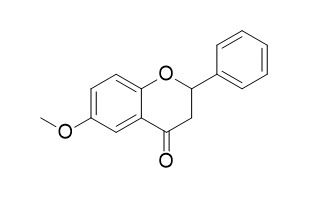6-Methoxyflavanone
6-Methoxyflavanone (6-MeOF) is a positive allosteric modulator of GABA responses at human recombinant GABAA receptors. 6-MeOF attenuates mechanical allodynia and vulvodynia in the streptozotocin-induced diabetic neuropathic pain. 6-MeOF has immunostimulatory activity.
Inquire / Order:
manager@chemfaces.com
Technical Inquiries:
service@chemfaces.com
Tel:
+86-27-84237783
Fax:
+86-27-84254680
Address:
1 Building, No. 83, CheCheng Rd., Wuhan Economic and Technological Development Zone, Wuhan, Hubei 430056, PRC
Providing storage is as stated on the product vial and the vial is kept tightly sealed, the product can be stored for up to
24 months(2-8C).
Wherever possible, you should prepare and use solutions on the same day. However, if you need to make up stock solutions in advance, we recommend that you store the solution as aliquots in tightly sealed vials at -20C. Generally, these will be useable for up to two weeks. Before use, and prior to opening the vial we recommend that you allow your product to equilibrate to room temperature for at least 1 hour.
Need more advice on solubility, usage and handling? Please email to: service@chemfaces.com
The packaging of the product may have turned upside down during transportation, resulting in the natural compounds adhering to the neck or cap of the vial. take the vial out of its packaging and gently shake to let the compounds fall to the bottom of the vial. for liquid products, centrifuge at 200-500 RPM to gather the liquid at the bottom of the vial. try to avoid loss or contamination during handling.
Pak J Pharm Sci.2023, 36(1):51-57.
Food Science and Preservation2024, 31(3):486-498.
Biomed Pharmacother.2022, 156:113929.
Biochem Biophys Res Commun.2017, 494(3-4):587-593
Molecules.2020, 25(3):734
J of the Korean Society of Cosmetics and Cosmetology2019, 225-231
Food Chem X.2024, 24:101909.
Int J Mol Sci.2019, 20(21):E5488
Mol Biol Rep.2024, 51(1):117.
Synthetic and Systems Biotechnology2023, j.synbio.
Related and Featured Products
Phytomedicine International Journal of Phytotherapy & Phytopharmacology, 1996, 3(2):191.
Actions of some flavonoids on specific and non-specific immune mechanisms.[Pubmed:
23194969]
The immunomodulatory activity of some flavonoids on antigen specific humoral and cell mediated immune responses and complement-mediated hemolysis has been investigated and compared with that of levamisole.
METHODS AND RESULTS:
Flavanone, 6-Methoxyflavanone, 7-methoxyflavanone and bavachinin enhanced the sheep erythrocyte (SRBC), induced primary and secondary humoral immune responses in mice, and 6-hydroxyflavanone, 7-hydroxyflavanone and rutin inhibited primary response. Levamisole slighly stimulated the primary and suppressed the secondary response. All the flavonoids tested decreased the manifestation of SRBC induced delayed type hypersensitivity reaction and showed no effect on classical or alternative pathway dependent hemolysis.
CONCLUSIONS:
The studies revealed the significant immunomodulatory potential of these flavonoids, methoxy derivatives having immunostimulatory activity and hydroxy derivatives immunosuppressive properties.
Biomedicine & Pharmacotherapy, 2016, 84:962-971.
6-Methoxyflavanone attenuates mechanical allodynia and vulvodynia in the streptozotocin-induced diabetic neuropathic pain.[Pubmed:
27764759 ]
Diabetic neuropathy is the most prevalent, persistent and debilitating complication of diabetes mellitus often coupled with vulvodynia that may present as an isolated symptom or as a part of constellation of other neuropathic abnormalities.Flavonoids have selective affinity for GABA receptors and 6-Methoxyflavanone (6-MeOF) is a positive allosteric modulator of GABA responses at human recombinant GABAA receptors. GABAergic and opioidergic system inhibition have been shown to facilitate neuropathic pain.
METHODS AND RESULTS:
6-MeOF was evaluated for analgesic effect in the hot plate test and streptozotocin-induced diabetic neuropathic pain in female rats using von Frey hairs. The possible involvement of opioidergic and GABAergic mechanisms was investigated using naloxone and pentylenetetrazole (PTZ) antagonists, respectively. The biodistribution of 6-MeOF in plasma and CNS was examined using a validated HPLC/UV analytical method. The binding affinity of 6-MeOF with opioid and GABA receptors was studied using molecular docking simulation approach.6-MeOF (10 and 30mg/kg) attenuated the acute phasic thermal nociception in the hot plate test while in the case of streptozotocin-induced diabetic neuropathy model, 6-MeOF (10 and 30mg/kg) produced static/dynamic anti-allodynic (increased paw withdrawal threshold and latency) as well as static/dynamic anti-vulvodynic effects (increased flinching response threshold and latency), when compared to the vehicle and standard gabapentin (75mg/kg). In silico studies depicted the preference of 6-MeOF for the delta- and kappa-opioid and GABAA receptors. Moreover, the pharmacokinetic profile revealed a quick appearance of 6-MeOF in the systemic circulation and brain areas with maximum concentration observed after 30min in the amygdala, brain stem and cerebral cortex.
CONCLUSIONS:
6-MeOF readily crosses the blood brain barrier and may be effective in attenuating the diabetes-induced allodynia as well as vulvodynia, probably through interactions with the GABAergic and opioidergic systems.
Molecules,2018 Oct 9;23(10):2578.
Glycosylation of Methoxylated Flavonoids in the Cultures of Isaria fumosorosea KCH J2.[Pubmed:
30304815]
Flavonoids are widely described plant secondary metabolites with high and diverse pro-health properties. In nature, they occur mostly in the form of glycosides. Our research showed that an excellent way to obtain the sugar derivatives of flavonoids is through biotransformations with the use of entomopathogenic filamentous fungi as biocatalysts.
METHODS AND RESULTS:
In the current paper, we described the biotransformations of five methoxylated flavonoid compounds (2'-methoxyflavanone, 3'-methoxyflavanone, 4'-methoxyflavanone, 6-Methoxyflavanone, and 6-methoxyflavone) in cultures of Isaria fumosorosea KCH J2. As a result, we obtained twelve new flavonoid 4-O-methylglucopyranosides. The products were purified with methods that enabled the reduction of the consumption of organic solvents (preparative TLC and flash chromatography). The structures of the products were confirmed with spectroscopic methods (NMR: ¹H, 13C, HSQC, HMBC, COSY).
CONCLUSIONS:
The compounds obtained by us expand the library of available flavonoid derivatives and can be used in biological research.



